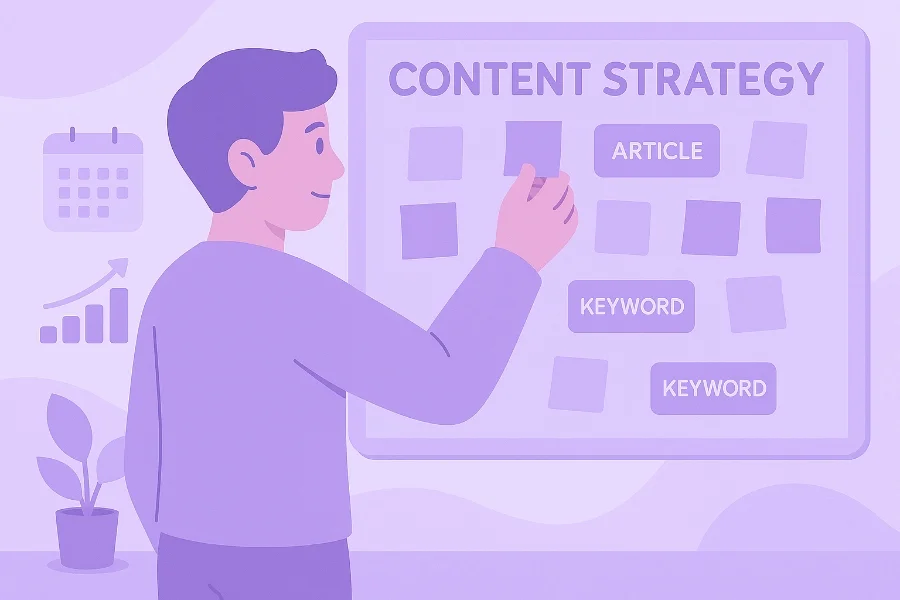SEO-friendly content strategies are one of the fundamental pillars for achieving good visibility in search engines. It is not enough to include keywords without context: it is about developing a comprehensive approach that combines content quality, user intent, and the technical factors Google deems relevant. The goal is not just to attract more visits but to generate qualified organic traffic that is genuinely interested in your products or services. In this article, we will explore in depth the best content practices for SEO and how to implement them successfully.
Importance of Using Optimized SEO Content
Creating SEO-optimized content is one of the most effective ways to position your website in top search results. Content acts as the bridge between user queries and the solutions your business offers. No matter how good your technical structure is, if you’re not properly communicating your value through content, achieving sustainable results will be difficult. Additionally, well-developed SEO content increases domain authority, improves user experience, and enhances both internal and external linking.
A solid SEO positioning strategy begins by building relevant content that aligns with your audience’s real searches and complements the site’s technical aspects.
Valuable Content to Improve Organic Traffic
Google rewards sites that provide real value to users. This involves developing clear, relevant, updated content that responds to specific questions or needs of the target audience. It’s not just about informing but doing so with depth and usefulness. Valuable content not only attracts more traffic but also generates interactions: comments, time on page, backlinks, and conversions. In the context of a complete SEO strategy, valuable content is a critical component for gaining sustainable visibility.
For example, if you have a blog focused on digital marketing, a comprehensive guide like “how to conduct a basic SEO audit” can become a reference resource for your readers. Including screenshots, downloadable templates, or explanatory videos adds even more value.
Key Factors Google Considers in Content
Before you start producing content, it’s important to understand what aspects Google values in its algorithms. These are some of the main factors:
- Relevance: Content must align with the user’s search intent.
- Quality: Well-written texts, free from spelling, grammatical, and syntactical errors.
- Originality: Avoid duplicated content and create unique pieces that stand out.
- User Experience (UX): A clear structure, good design, functional links, and fast loading times enhance SEO content performance.
These elements not only affect your ranking but also directly influence brand perception and user retention.
Strategic Use of Keywords
Keywords are essential for search engines to understand your content’s topic. But their use must be natural and strategic, avoiding over-optimization or forced keyword stuffing. The key is to integrate them organically into headings, subheadings, opening paragraphs, image alt attributes, and meta descriptions.
It’s also advisable to use semantic variations and synonyms to broaden content reach without losing coherence. A well-executed keyword strategy can position your site for multiple related queries and attract different user profiles.
Keyword Research and Its Impact on SEO
The starting point for any SEO content strategy is keyword research. Tools like Google Keyword Planner, SEMrush, or Ahrefs allow you to identify terms with good search volume, low competition, and high relevance to your business. This information helps you plan your editorial calendar, focus content on what your audience is actually searching for, and anticipate trends.
For example, if your main keyword is “SEO content strategies,” you could find related terms like “improve ranking with content,” “effective SEO content,” or “SEO writing for blogs.” Integrating these variants coherently into your text increases your chances of appearing in various searches.

Long-Tail Keywords to Capture Qualified Traffic
Long-tail keywords are more specific expressions that attract users with a very defined intent. Although their search volume is usually lower, their conversion rate is significantly higher, as they connect with specific needs.
Instead of focusing on generic words like “marketing,” it is much more effective to target phrases like “digital marketing strategies for fashion ecommerce.” This approach not only improves your visibility but better segments your audience and enhances your content investment return.
Creating Valuable Content for Users
A good content strategy is not only about ranking but also about solving problems. Each content piece should have the main goal of helping the reader, answering their questions, guiding them, and offering actionable resources. This service mindset builds trust, retains users, and contributes to a professional and expert brand image.
Solving User Problems Improves SEO
When you manage to help users find clear and useful answers on your site, the chances of them interacting with your brand, subscribing to your content, or even hiring your services increase. Providing solutions through content has a direct impact on SEO, as it improves time on page, reduces bounce rate, and boosts natural linking.
For example, an article on “how to choose an ecommerce platform” can include a comparison table, tips based on business type, and recommendations based on budget. This type of content, when well-crafted, builds trust and drives conversions.
SEO Content Optimization Based on Search Intent
Each type of query users make on Google responds to an intent: informational, transactional, or navigational. Identifying that intent and adapting the content’s format and style is key to meeting reader expectations and improving rankings.
- An informational search may require a guide, a detailed article, or a list of tips.
- A transactional query benefits from calls to action, product comparisons, and testimonials.
Understanding these differences allows you to structure content more effectively and increase conversions.
Content Updating for SEO and Continuous Improvement
One of the most common mistakes is publishing content and leaving it untouched. Google values fresh information, especially in sectors like technology, health, or marketing. Reviewing your content periodically, adding updated data, and keeping links active is an effective way to maintain your ranking and attract new traffic.
Keeping Content Updated
Updating content periodically not only improves SEO but also conveys professionalism and a commitment to quality. You can do this by adding new sections, including recent screenshots, changing calls to action, or expanding answers to frequently asked questions. You can even adapt the language or focus based on market changes or audience needs.
This approach is even more effective when paired with a website specifically designed for SEO positioning, such as those developed through a professional web development service focused on SEO from the structure.
Recycling Old Content to Gain Relevance
A very effective but often overlooked strategy is recycling old content into new formats and contexts. This approach allows you to leverage articles that have already performed well and adapt them to new channels or consumption styles. For example, a long-form article that has generated consistent traffic can be turned into a series of social media posts, a webinar presentation, or even a downloadable infographic. This practice not only saves production time but also reinforces the authority of already-ranked content.
Moreover, content recycling allows you to update information without starting from scratch, which is useful in sectors where trends and tools are constantly changing. It also contributes to an omnichannel content strategy, where the same message is adapted to different formats to reach diverse audiences.
Diversification of Content Formats
Content is not limited to written text: to achieve a comprehensive SEO strategy, it’s necessary to diversify formats and offer enriching experiences for different types of users. Including videos, infographics, downloadable guides, podcasts, or even interactive calculators can increase time on site and reduce bounce rates. Both are positive signals for search engines and reinforce your organic positioning.
For example, a step-by-step guide on implementing SEO strategies can be presented as an article, but also as a downloadable checklist or a video tutorial. This variation not only expands reach but also adapts to each user’s preferences. A well-thought-out multi-format strategy strengthens your brand and brings versatility to your content.
Impact of Photos and Videos
The use of visual resources has a great impact on both user experience and SEO. Images and videos not only enrich textual content but help explain complex concepts, generate better retention, and improve understanding. Also, pages with well-optimized visual content tend to have better engagement and time-on-site metrics, which Google interprets as quality signals.
For optimal results, it’s important to follow best practices such as using descriptive file names, including keywords in alt tags, and compressing images to avoid slowing down site speed. Videos should be contextually integrated and, if possible, accompanied by transcripts or summaries to enhance their informational value.
Use of Infographics, Guides, and Case Studies
Infographics are especially useful for presenting technical or statistical information in a visual and understandable way. This type of resource facilitates quick content scanning and is highly shareable, which can translate into backlinks and increased social media visibility. Meanwhile, practical guides and case studies provide depth and authority, two aspects highly valued by both users and search engines.
Including these resources in a content strategy allows you to capture leads, generate downloads, increase interaction time, and offer high-perceived-value content. Furthermore, these materials are ideal for complementing email marketing and remarketing strategies, as they serve as anchor content to educate and nurture prospects.
Proper Content Structure
It’s not enough to have good content: it must also be well-structured. A clear, hierarchical, and visually pleasant text improves user experience and facilitates search engine crawling. The correct use of headings (H1, H2, H3), descriptive subheadings, balanced paragraphs, and visual elements provides a logical order that guides the reader and allows smoother reading.
Additionally, a proper structure helps Google’s featured snippets extract information from your page. This can lead to higher click-through rates (CTR) from search results. Therefore, it is advisable to plan each content’s structure from the drafting phase, thinking about both user comprehension and algorithm criteria.
Optimized Headings (H1, H2, H3) and Subtitles
Headings are key to organizing information and improving visual scanning. Correctly using H1, H2, and H3 tags helps establish thematic hierarchies within the content. The H1 should be unique and represent the article’s main topic, while H2s group relevant sections and H3s organize subsections within them. Integrating relevant keywords into these titles enhances positioning without forcing content.
It is also important for subtitles to be descriptive and appealing, as they act as visual anchors for readers skimming the article before deciding to read it fully. This way, each section becomes a valuable unit within the text.
Lists and Short Paragraphs to Improve User Experience
Although we’ve expanded paragraphs to provide more value, it’s essential to maintain readability. Using bullet or numbered lists allows you to break down complex information into easily digestible fragments. This is especially important on mobile devices, where users tend to scan rather than read in depth.
Breaking information into well-defined blocks improves reader retention and reinforces message clarity. It also helps search engines identify the content’s key points. Alternating between longer paragraphs and visually accessible fragments creates a comfortable and engaging reading rhythm.
If you’re developing a content strategy and need a website ready to rank from day one, our web development service is designed to help you stand out with a technical and visual structure optimized for SEO.



0 Comments